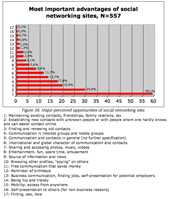Social Networking Sites Study
Last modified: October 12, 2011Social Networking Sites and the Surveillance Society
studiVZ, Facebook. MySpace: First study of social networking sites in Austria
Fuchs, Christian. 2009. Social Networking Sites and the Surveillance Society. A Critical Case Study of the Usage of studiVZ, Facebook, and MySpace by Students in Salzburg in the Context of Electronic Surveillance. Salzburg/Vienna: Research Group UTI. ISBN 978-3-200-01428-2.
Press Release (January 2009)
 |
 |
 |
| Image: Usage rates of SNS (Click to enlarge) | Image: Perceived advantages of SNS von SNS (Click to enlarge) | Image: Perceived disadvantages of SNS (Click to enlarge) |
674 students from Salzburg participated in the study that was conducted by the eTheory Research Group (University of Salzburg, ICT&S Center). 88.3% of the respondents use studiVZ, 39.5% Facebook, 15.9% MySpace, 9.0% Xing, 7.4% Lokalisten. Each of 61 other social networking sites (SNS) is used by less than 1%. Study author associate professor Christian Fuchs: “There are indications for a strong economic concentration in the area of social networking sites. On the one hand concerning usage, but as a consequence on the other hand also in relation to profits that are made by advertising”.
59.1% of the respondents see the maintenance of social contacts as the biggest advantage of SNS, 55.7% say that economic and political surveillance is the greatest risk. Fuchs: “Students are very aware of the massive collection of personal data on these platforms, they use them nonetheless because of the expected communicative advantages. This does not mean that they are incautious, but that there is a structural lack of alternative platforms. Non-commercial, non-profit SNS do not have to evaluate data for personalized advertisements, therefore the probability of surveillance and data abuse decreases. But such platforms are currently hardly existent or completely unknown, therefore young people − the main usage group of social networking sites − have to rely on commercial service providers that collect, store, and evaluate personal data in order to accumulate profits by targeted advertising”.
81.8% of the respondents have little knowledge about concrete data surveillance in Europe (e.g. the Data Retention Directive or the Austrian Security Police Act). But 67.4% have a critical standpoint towards surveillance. 88.7% of the studiVZ users have good or very good knowledge about what happens with their data on the platform. The same is true for only 35.9% of Facebook users and 22.6% of MySpace users. Fuchs: “Students are generally critical towards surveillance, but they only have little concrete knowledge about the existing political regulations. Users‘ rather high degree of knowledge about studiVZ and their rather critical information behaviour on this platform, contrast with knowledge and information behaviour on Facebook and MySpace. This can be explained by the change of the terms of use that studiVZ undertook at the beginning of 2008 and that introduced targeted advertising. The introduction was accompanied by a self-organized information campaign that students conducted on the platform and public discussions that presented studiVZ as the “sniffleVZ” (=SniffleDirectory). This campaign can be interpreted as a form of fragmented public. Its success was very limited. Nonetheless it has resulted in the fact that many students have read the new terms of use and have opted out of standard advertising options, which was not the case on other platforms”.
The study recommends that citizens see commercial Internet platforms that store and evaluate personal data generally critically and that by establishing special consumer protection websites it could be documented in the public, which rights in dealing with personal data such platforms obtain by their terms of use and their privacy terms. Christian Fuchs: “There are many examples for how affected citizens try surveilling the surveillors with the help of websites. This can pose a certain degree of protection by making use of public information, but also has limits because the basic problem is that we live in times, in which on the one hand there are strong commercial interests in data collection and data evaluation and on the other hand after 9/11 continuously more political steps have been taken for creating surveillance societies. These are political-economic problems, not technological ones”
The expertise of the study will be part of the Europe-wide research project “Living in Surveillance Societies” of the European Science Foundation, in which Christian Fuchs represents Austria in the management committee.
Media Coverage:
ORF Futurezone, 19.1.2009:” studiVZ bei Studenten am beliebtesten: Studie zur Nutzung von Social Networking Sites in Salzburg” Link
Salzburg TV, 29.1.2009: Ausgesprochen Salzburg: “Gefahr und Potenzial von studiVZ & Co” Link
Der Standard, 7.5.2009: Nutzer von Facebook & Co: Keine Freude mit persoenlicher Werbung Link
Die Presse, 7.5.2009: Nutzer von Facebook & Co: Keine Freude mit persoenlicher Werbung Link
Oberoesterreichische Nachrichten, 7.5.2009: Nutzer von Facebook & Co: Keine Freude mit persoenlicher Werbung Link


Danke für die sehr spannende Studie! Bitte mehr davon!
das gilt jetz aber nur für studenten! auf die gesamtbevölkerung gesehen (man beachte vor allem; schüler!) schauts da sicher etwas anders aus!
Gibt es Pläne, die Studie auf andere Bevölkerungsschichten auszuweiten? Das könnte in der Tat einiges an den Ergebnissen ändern bzw. weitere Schlussfolgerungen zulassen.
Interessant, wie die weite Welt des Social Web von österreichischen Studenten angenommen wird. Die Akzeptanz von studiVZ ist schon enorm. Eine andere Stichprobe würde auch interessante Ergebnisse zu Xing & Co. liefern, dort tummelt man sich offensichtlich erst nach dem Studium.
Es gibt gemeinnützige und nichtkommerzielle Initiativen, um Social Networks der Allgemeinheit zur Verfügung zu stellen.
Eine der wenigen ist die OpenNetworX-Stiftung; http://www.opennetworx.org
Die gemeinnützige OpenNetworX-Stiftung mit Sitz in Hamburg wurde im Oktober 2008 gegründet und betreibt die OpenNetworX Internetplattform.
Ziel von OpenNetworX ist es, Bildungsinstitutionen und gemeinnützigen Organisationen kostenlosen Zugang zu einem der modernsten Kommunikationsmittel zu geben; dem internetbasiertem sozialen Netzwerk. Unsere Netzwerke erleichtern es Schulen, Universitäten und Vereinen, ihre Schüler, Studenten und Mitglieder u.a. miteinander zu verbinden und mit diesen zu kommunizieren – und tragen somit ganz erheblich zur Erfüllung ihrer Bildungsaufträge bzw. Stärkung ihrer gemeinnützigen Aktivitäten bei.
Die OpenNetworX-Plattform ermöglicht die Gründung und Administration von sozialen Netzwerken, die nicht nur technologisch hochwertig, sondern auch vollständig werbefrei und kostenlos sind. Die OpenNetworX Stiftung finanziert sich wie Wikipedia durch Spenden, so dass sie allen Beteiligten den Schutz ihrer Daten garantieren kann. Darüber hinaus unterstützt die OpenNetworX Stiftung Bildungsinstitutionen und gemeinnützige Organisationen auch kostenlos bei der Einrichtung, Konfiguration, und Design der Netzwerke. Sehr gerne arbeiten wir auch in Kooperationen – wie z.B. mit der Universität Madgeburg – um gemeinsam Projekte zu realisieren oder die Plattform zu verbessern.
Hier einige Beispiele, wie OpenNetworX-Netzwerke eingesetzt werden können;
* Bildungsnetzwerke; Bildungsinstitutionen können Netzwerke errichten, um Bildungs-, Wissens- und Kommunikationsräume für Studenten und Dozenten bzw. Lehrer und Schüler im Sinne einer „digitalen Lern- und Schul- bzw. Universitätskultur“ zu erschließen.
* Alumni-Netzwerke; Universitäten und Schulen können in Alumni-Netzwerken ihre Ehemaligen verbinden und Alumni-Arbeit betreiben, um so die Berufsbildung zu fördern. Zur Optimierung der Berufsbildung können Bildungsinstitute je ein Netzwerk für ihre aktiven und ihre ehemaligen Studenten/Schüler einrichten, damit ein durchlässiges System entsteht und beide Gruppen in Kontakt treten können.
* Netzwerke für Vereine und andere gemeinnützige Organisationen; Vereine und andere gemeinnützige Organisationen können Netzwerke zur Stärkung ihrer gemeinnützigen Aktivitäten errichten; entweder als geschlossene Netzwerke zur internen Kommunikation („Intranet“), oder als offene Netzwerke u.a. zur externen Darstellung und Werbung neuer Mitglieder.
* Medienbildung für Schüler; Wir planen geschlossene Netzwerke für Schulen einzurichten, in denen Schüler – unterstützt durch ein entsprechendes medienpädagogisches Programm – gefahrlos erste Erfahrungen im „Web2.0“ sammeln können.
Die Verteilung der SNS variiert tatsächlich sehr stark, je nach Alter und auch regional. Ich kenne andere Studien die sich u.a. mit SNS auseinandersetzen und hier siehts gleich anders aus.
I’ve wrote an enhancing feedback article to your Social Networking
Sites article; knol.google.com/k/alexander-orlov/the-danger-of-a-vendor-lock-in-of
[...] Social Networking Sites Study [...]